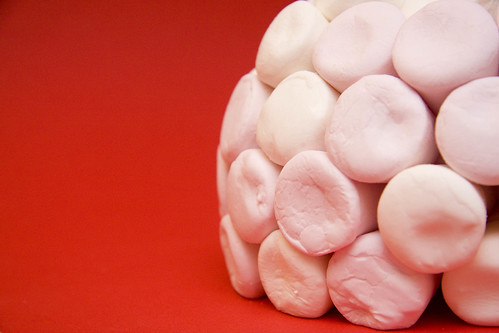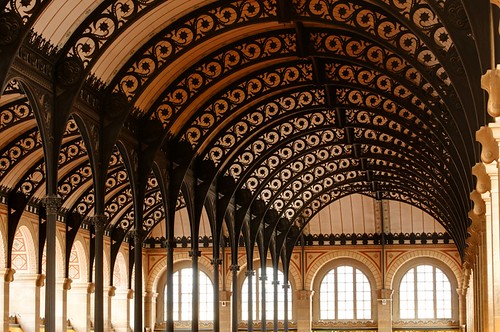Building Types we are investigating:
2. #006 Agricultural
3. #007 Shops, Mews & Restaurants
4. #008 Public Buildings
5. #009 Commercial Buildings (last week)
| Drawing of Marshall's Mills, Holbeck showing operators at their machines. From the Penny Magazine Supplement, December 1843 "A Day at a Leeds Flax Mill" Image courtesy of Wikimedia Commons |
6. #010 Industrial Buildings (today!)
7. #011 Sports Buildings, Theaters & Churches
Wahoo! We made it to Industrial Buildings. I always think of cool vintage warehouses and factories built of brick and steel when I think industrial, but let's get a slightly more formal definition:
The Industrial Revolution(s)
Industry is the business of manufacture or fabrication, basically since the first Industrial Revolution (starting in about 1760). Before that
| The Crystal Palace Interior, London McNeven, J., The transept from the Grand Entrance, Souvenir of the Great Exhibition, William Simpson (lithographer), Ackermann & Co. (publisher), 1851, V&A Image courtesy of Wikimedia Commons |
On one hand, struggling families had more wage-earners. On the other hand, the working conditions (inadequate ventilation, loud machinery, VERY long hours by our standards, repetitive labor, etc.) did not contribute to good health; by the way, children and the elderly are much more susceptible to a poor environment than adults in their prime.
In spite of these challenges, it is hard to say that
| Over London–by Rail from London: A Pilgrimage (1872) Gustave Doré, courtesy of Wikimedia Commons |
The Industrial Revolution began a new phase in the mid-1800s, with the spread of steam power and more readily available machinery.
Industry continued to explode with the mass production (requiring standardized parts) and assembly lines like those of Henry Ford into the early 1900s.
What did this mean for industrial buildings?
Clip from the BBC 2004 miniseries adaptation of Elizabeth Gaskell's 1854 novel North and South,
a beautiful story set within the challenges and beauties of the late/2nd industrial revolution.
In this clip, Margaret Hale sees the cotton mill for the first time, and the fury of the
master when a worker is found smoking and endangers the entire mill (violence warning).
Margaret says, "I believe I've seen hell: it's white. It's snow white."
(Yes, that's Richard Armitage, otherwise known as Thorin Oakenshield of the Hobbit.)
Fast forward: #5 Highland Park Ford Plant from 22:15 - 26:50
Industrial Buildings
| Marshall Field Warehouse in 1890 by Henry Hobson Richardson (built 1887) Image courtesy of Wikimedia Commons |
Location Location Location
Industrial buildings need lots of materials delivered to create their product and typically need to distribute their completed product.
That means transportation: docks, railroads, and other transportation hubs.
Program
What the workers really needed was daylight & fresh air. Improved worker comfort = better productivity. And the more comfortable and healthy workers are, the longer they stay: the less an employer has to pay for worker training. Win-win.
What the equipment and mass production needed was open floor plans uninterrupted by columns.
 |
| Image courtesy of j burkhalter via Flickr |
All That Uninterrupted Space
Fewer columns and bigger windows mean longer spans: you need better beams!
Almost all the beams in the pre-industrial world were made of wood. They could only be as long as the available trees were tall. And only as strong as they were deep....
By "deep," I mean how tall from top to bottom when in place. For example, a 2x12 (2" x 12" deep) pine beam will span a greater distance than a 2x8 beam. Of course there are factors other than depth to consider when sizing beams (like wood species, wood grade, allowed deflection, etc.), but all other things equal, depth is the superstar when it comes to simple spans.
| Pratt Truss, patented in 1844, Boston Image courtesy of ZabMilenko via Wikimedia Commons |
Somewhere along the way, someone was unimpressed with his lumber choices and thought, "Can't I just build a deeper beam with smaller pieces?" Enter the truss.
Side Note: Tensile Strength vs. Compressive Strength
 |
| When a beam deflects under load, its top compresses while its bottom stretches in tension. |
Tensile = stretching without breaking
Compressive = squishing without being crushed
Walls--in order to support the weight of a roof--need to have compressive strength: not be squishable. Imagine if your walls were made of
 |
| marshmallow igloo Image courtesy of phil wood photo via Flickr |
Rubber bands would make terrible walls, but they are very strong in tension: they can stretch very far without breaking.
The cool thing about wood is that when used correctly, it is pretty good at both compression and tension, which makes it an awesome material for a beam or truss.
And with all manner and shape of trusses, no
 |
| Iron frame with arched trusses Library Sainte-Geneviève, Paris, by Henri Labrouste Image courtesy of jastrow75 via Flickr |
New & Improved Spans
So you need something stronger than wood in compression and tension to span greater distances. What do you use?1. iron frame (1840)
2. reinforced concrete frame (1870s)
3. steel frame (beginning in 1880)
Iron was great, except that its strength
| Rand McNally Building, Chicago. First steel frame building in America 1889 by Burnham and Root, demolished in 1911 Image courtesy of Wikimedia Commons |
We still use reinforced concrete and steel frame for most buildings that are not residential.
Note: concrete is really awesome at compression, and the steel that "reinforces" it from the inside is excellent at tension. When they work together as a unit, they can be very deep and very strong.
Homework #010
Visit an industrial building. This one may be hard, because most factories & warehouses are secure. Viewing from the street may have to suffice!
 |
| brick-faced warehouse Sterrett at McKee, Houston Image courtesy of Patrick Feller via Flickr |
- Determine what the structure is made of. Note: many older industrial buildings will have a concrete or steel frame, but the walls are filled in with brick. These bricks are not part of the "structure," holding everything together. They are just separating the inside from the outside. And yet, sometimes, all you can see is the brick and it's impossible to tell what the structure is built from, like the image on the right.
- Are there plenty of windows to let the daylight in?
- Is it an old building that is outdated for manufacturing? If so, has it been abandoned or adapted for a new life as apartments, lofts, or offices?
Cheers!
ally